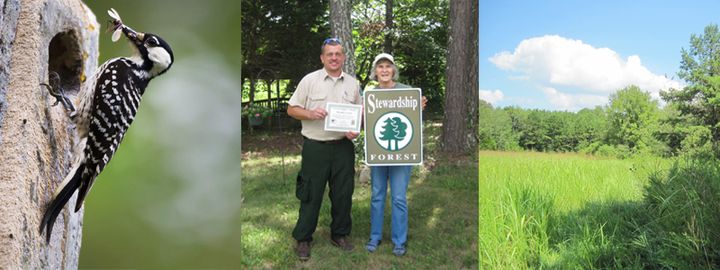
In the midst of rising numbers of at-risk wildlife in the South, the American Forest Foundation recently released a new report that showcases private and family landowners are key to conserving and protecting wildlife across the South. With 87 percent of forest owners owning land for its wildlife value, and 73 percent stating they interesting in doing more for wildlife, the numbers tell a compelling story.
But what is more powerful are the stories of landowners in action – that shows how the passion and conservation instincts of landowners can help wildlife species, with the right resources and assistance.
Take a look at Dorothy of north Alabama. Dorothy first purchased her property more than 40 years ago. During the early years, Dorothy’s family enjoyed their woods as they were: the trees blooming each spring, the wildlife roaming and feeding on the land, song birds coming and going. She would see logging trucks go by on her quiet road, but she never considered harvesting timber or land management as options for her. Her focus was on the critters. Dorothy thought she was doing the best possible for the health of her woods and the wildlife in it by simply leaving the forest alone, and letting nature take its course.
After Dorothy retired, she began to notice that that wildlife she was accustomed to seeing weren’t wandering her woods anymore. The ground was becoming thick with growth. Kudzu was taking over a big section of trees and it was hard for her to walk through her property.
A friend recommended she talk with the Alabama Forestry Commission. She set up a meeting with a forester and they spoke extensively about what Dorothy wanted to get out of her woods. Dorothy was surprised to learn how management practices like treating invasive species and thinning the old trees could be good for wildlife. Dorothy’s forester also pointed out the abundance of shortleaf pine on her land, a species that has been in decline elsewhere.
Shortleaf pine used to thrive across the Cumberland Plateau. For the communities, it supported jobs and wood for the forest products industry, and gave residents a place to hunt or fish. For wildlife, it provided habitat and a food source.
But since the end of the Civil War, this pine species has been in decline. Due to many historical factors: the influx of settlers; the conversion of forests to agriculture land and commercial development; the suppression of natural fire; and the invasion of non-native species, such as kudzu, shortleaf began to dwindle. Today, it is found on less than 200,000 acres across the region, representing a more than 50% decline in its range.
The loss of this forested habitat has had ripple effects on wildlife. A significant number of species are now at risk. Already 92 species are listed as threatened or endangered, including the red-cockaded woodpecker. Another 71 species are on the candidate and petition list for the future.
But over the past two years, the caretakers of Alabama’s forests – private and family landowners like Dorothy – have stepped forward and begun working with foresters and organizations like the American Forest Foundation to help reverse this dwindling habitat.
Dorothy’s forester, immediately saw her passion and interest in helping wildlife. He and the Alabama Forestry Commission, along with Alabama Forestry Association, Auburn University, National Wild Turkey Federation, U.S. Forest Service and others, are part of a conservation partnership initiative with the American Forest Foundation. Together, they are helping landowners restore this historically dominant habitat and ecosystem. By conducting outreach, hosting field days and having one-on-one meetings with trusted resources, the partnership provides the technical and cost-share assistance landowners need.
Dorothy attended one of these field days, and has since put together a management plan to restore her forest. With a focus on wildlife, her plan includes activities to aid the growth of shortleaf pine and enhance the health of her woods. Already, Dorothy has treated the kudzu and other invasive species on her land. She has scheduled her first prescribed burn.
Dorothy is among nearly 350 landowners already involved and taking steps to help. Together they account for more than 28,000 acres of land.
Working with partners and landowners, together we can proactively tackle the challenges facing at-risk wildlife species, and ensure our forests continue to be productive.
If you are interested in getting involved in this effort, visit AFF’s Cumberland Plateau partnership webpage.
